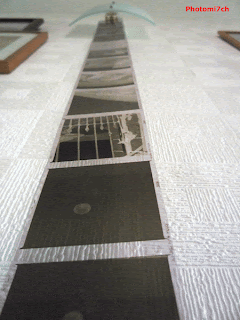I am writing this from the darkroom as I process the second roll of Bergger Pancro 400. It is being developed in Kodak HC 110 for 9 minutes I'm not sure how it is going to turn out as I forgot to soak it for a minute in clean water. I knew something was a miss. It is becoming a joke, nearly every film processed this year, has had a fault one way or another. I will be pleased to get back to the mundane predictability of old. In more ways than one.
Now with the film hanging up to dry I can get back to what I wanted to write. I'm pleased to say that the initial look over the negatives is good in comparison to one I did correctly. I will only know for sure when I start printing.
As you may have already gathered the film needs to be soaked for a minute before the developer go's in. When you pour the water out it has a very slight colour to it. Stop bath is as normal for those that use it but you must fix the film for six mins or longer depending on how old your fix is. Agitation for the developer is for the first 30 seconds (twelve inversions) and then for 5 sec's every 30seconds ( two inversions.) If you tumble your tank instead of twiddling. When you open the top to pour away the developer there will be bubbles in the top so far I have not noticed any problem with the look of the negatives.
The lock down has found me time to slow down and consider what I should do. While I mulled things over I did a bit of surfing those were the days now it is just the net for information on macro photography. It became clear that it would be best to use a fast film because of the drop off in light reaching the film plane when using a bellows. I'm in trouble I have no 400 ISO film in 120 while I was surfing down the pipe I came across references to film called Bergger. It did not take long before the screen was swamped with peoples opinion on this film. I scratched the surface to see what was said and looked at the pictures it produced. I was disappointed to find that most of it was scanned negative. One video I watch stated the negatives were flat. I'm pleased I took no notice as the results I have hanging up to dry show otherwise.
I have long held the view that one favourite film developer at a certain dilution should not be a catch all for all makes of film and that a comfort zone is the enemy of creativity and missed opportunity. Manufactures go to great lengths to produce a developer that best brings out the qualities of their film and as I have discovered Bergger is no different only in this case their film has a twin layer of emulsion giving it its full light sensitivity hence the name Pancro. Which would suggest a look all of its own. A comparison of their developer could be on the cards?
For instance I chose to use HC 110 to develop the film, it could quite easily have been Rodinal or one of the half dozen others I have on the shelf but had in mind the fine grain qualities of HC 110. Fast films are not known for there fine grain unless it is a T grain. I should add that the developer you choose has a big influence on the size of grain and the character of the negative and therefore should be given due consideration.
When doing something like this the first time it is a leap of faith that all the information about development is correct. I have found that the time suggested for HC 110 produces a negative that is a little on the thin side for me. It has shown its self in the darkroom with shorter than my usual exposure times. I may increase the development time but for now I'm going to let it stand until I have processed a few more rolls.
I have exposed a number of rolls of Pancro 400 at box speed. Most of it in high contrast conditions. In some cases with the lens closed down to F 32 at 500th of sec. it has managed to capture a wide range of detail from darkest to brightest. All waiting for you to utilize when exposing it to your chosen paper if you wish. I have found printing these negatives to be some of the easiest. The whites are brilliant and detailed to a degree I have not noticed before with other film. The blacks are rich and pure but can also be very detailed.
One note of caution it is quite easy to over expose the paper due to the extra tone and crisp detail. I have discovered that I am trying to have it all leading to overly dark and sometimes muddy photographs. With the saying less is more in mind it has lead to some wonderful photographs that are a joy to behold.
You should give Bergger Pancro 400 a go if you have not already done so and print it in the darkroom. Scanning does not do it justice.
A note of caution when using out dated 120 film it can become very grainy even with HC110 when pre soaking, I suggest not doing so to reduce the look of grain.
Technical Data:
All black and white images have been scanned from prints. Contact printed on Ilford MG 5 RC G. Key printed on Kentmere RC G, Containers of fruit printed on Ilford MG FB, All developed in multigrade.
The picture of the graduate is used HC 110.



































